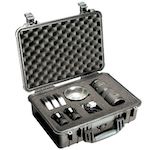So you've got your camera, lenses, and lighting - but that's not all you're going to need! When shooting a specialized genre like architecture, there are plenty of accessories that will make your life so much easier, and some that you just can't live without. From tripods to batteries, I break them down and make sense of the hugely diverse field of options.
CamRanger My personal favorite accessory for shooting architecture, interiors, and real estate. In essence, wireless tethering, in practice, so, so much more. Style a room, adjust light power, adjust camera settings, light multiple parts of a room, view your work on a large screen, hand off an iPad to a client to review images. All wirelessly. All without going back and forth to a camera. All without lugging a laptop around. I love this thing. Read my full review here.
This fantastic carbon fiber tripod that dampens vibrations and can be used well both inside and outside. It has some good height even for a taller guy like me and comes up to my eye level, the place you want your tripods to sit. The tripod comes with an extendable center column, a must have for architectural photography.
The Manfrotto MT055CXPRO3 Carbon Fiber Tripod is a simpler tripod I use that remains quite reliable. I used this tripod a great deal in my first tutorial. This tripod is great for using in smaller more compact spaces.
The Manfrotto 161MK2B Super Professional Tripod Mk2 is the latest version of the Bogen 3258 and is a great tripod when the job calls for some major height. I normally use this when I'm shooting a really high building or shooting on a steep hill. This is not an item I would choose to travel with; rather, I leave it in the back of my car for more local jobs.
The Arca-Swiss C1 Cube Geared Head is a luxury item for any architectural photographer as it comes with a hefty price tag but once you use it, you'll understand why it has a high price. The cube allows you to make fine tune adjustments that help you avoid the camera shift or sag that comes with a more standard ballhead. The cube is also self leveling which gives a great advantage when working on uneven ground.
The Manfrotto 410 Junior Geared Head has the same functionality as the Arca-Swiss C1 Cube Geared Head but is a little trickier to use. If you're on more of a budget, I recommend you go with this less expensive option. While it may not come with the finesse that the Cube has, you'll still get the job done just as well.
The Hoodman HoodLoupe comes in handy when shooting exteriors when it's bright outside. Direct sunlight inhibits my ability to see the back of the LCD and the Hoodman HoodLoupe helps to make sure I nail the exposure.
I use circular polarizers when I'm trying to reduce glare and cut down on reflections. I keep a set for my 77mm lenses as well as my 82mm lenses.
Power Packs have become essential on most of my shoots whether I'm charging an iphone or having it handy for my clients to charge up something out on location. There are plenty of varieties but I use this one made by Jackery.
Power Inverter When I'm traveling for long periods in the car or traveling overseas it is incredibly handy to carry a power inverter. This helps keep some of my larger items such as my laptop charged up and ready for a job. Just be careful and make sure you dont use it to fire your strobes as it will drain your car battery very quickly.
Rechargeable Batteries Sanyo Eneloops. Period. Don't waste your time with anything else. I use both their AA and AAA batteries. Speedlights go though batteries like water and you're going to save tons of cash in the long run by using rechargeables.
Battery Charger I own, at last count, over 60 rechargeable batteries. Charging them used to be a pain in the butt until I bought one of these. Titanium Innovations' charger will work on 16 batteries at once, will condition them when necessary, and tell you how much charge is left in each at a single glance. Also has two USB ports for easy device charging. These will charge a full load of 16 in just a couple hours. Great for traveling.
Pelican Cases Your gear is going to get tossed, rolled, dragged, and more, especially when shooting assignments that involve travel or being exposed to the elements. Everything I own is protected by Pelican cases. I personally own multiple 1650s, 1510s, 1560s, and little buddies like this for cards and other trinkets. I'd avoid the foam and go with the velcro inserts so you can best organize your gear within the case.














Is there any information on the free-standing monopod Mike talks about in the video (with the shorter legs and big rubber feet)?
I believe this is the exact one in the video: http://www.amazon.com/Manfrotto-MVM500A-Aluminum-Fluid-Monopod/dp/B00CBB...
When I upgraded to the Induro CT314 Carbon Fiber tripod, I thought it a bit over sized for my Nikon D300 and my D7000. However after a year of using it almost everyday in my business of real estate photography, I'm 100% sure it was a solid choice.
I really like the "half turn twist" leg locks because I'm constantly adjusting.